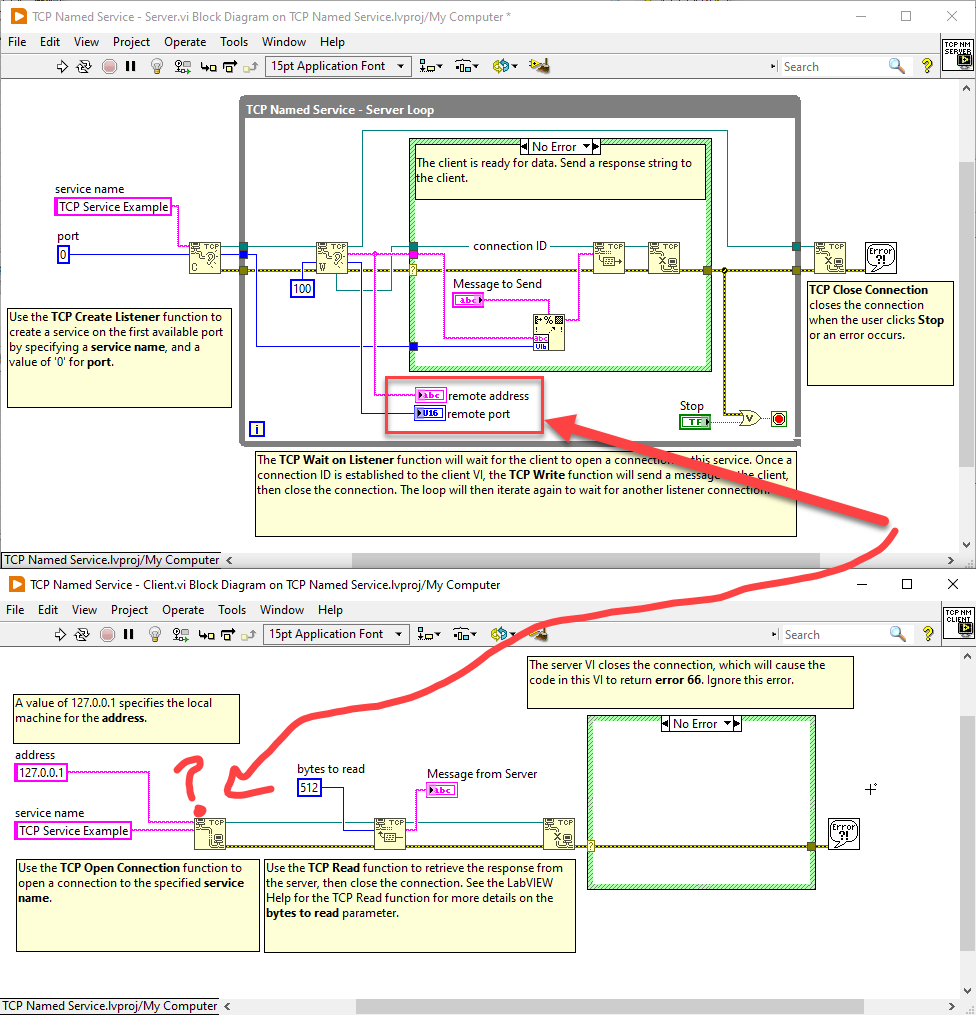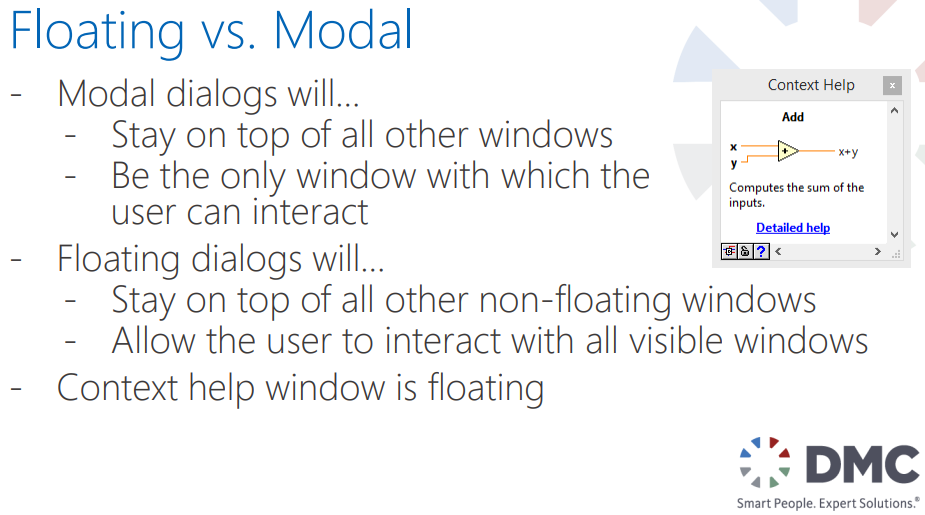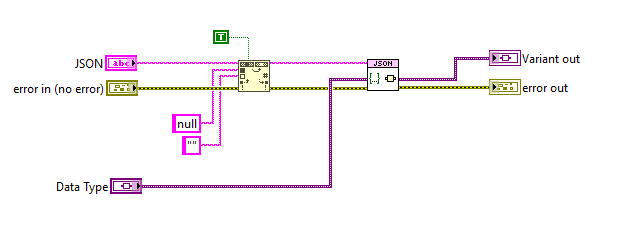-
Posts
159 -
Joined
-
Last visited
-
Days Won
11
Content Type
Profiles
Forums
Downloads
Gallery
Everything posted by bjustice
-
Question: is it possible to determine the local address and local port selected when using "TCP Open Connection" to connect to a TCP listener? It seems weird to me that the "TCP Wait on Listener" resolves and returns this information, but the TCP Client does not have a way to determine this information. Maybe I'm missing something. To be clear, I'm specifically considering a situation where my computer has multiple NICs. And I'd like to know which NIC is being used. I found a relevant idea exchange thread on asking to allow for LabVIEW to specify which NIC to use. https://forums.ni.com/t5/LabVIEW-Idea-Exchange/Allow-user-to-select-the-which-NIC-to-use-for-network/idi-p/1497368#comments Thanks!
-

What determines which monitor a dialog shows on?
bjustice replied to drjdpowell's topic in User Interface
I found this DMC slide. I wasn't quite sure when to use Floating vs Modal, and this helped me a bunch. In my situation right now, I like and am going to use Hoovahh's code to set to modal through VI server. Graceful. I really do appreciate this code that you shared. https://www.ieee.li/pdf/viewgraphs/user_interfaces_in_labview.pdf -

What determines which monitor a dialog shows on?
bjustice replied to drjdpowell's topic in User Interface
Thanks Hooovahh, I love this. When do you typically use "Floating" vs "Modal"? -

Event on Colour Change while widget is open, is this possible?
bjustice replied to Neil Pate's topic in User Interface
How much to bribe you for sharing this code? Very pretty, and cool to see good usage of the channel wire -
This is cool. I hadn't considered moveblock. Thanks for sharing
-
Hooovahh in the hole!
-
Really? You're suggesting that there's potentially a faster way to convert a u8 byte array to an array of DBLs? I hadn't considered that. I really thought that TypeCast would have been the fastest option. But, I also didn't realize that type cast used the string unflatten code under the hood until AQ communicated this.
-
oh, I do wish that the typecast allowed for me to specify endianess though. I recognize that the unflatten from string allows for me to specify endianess, but this is substantially slower than typecast. So, I often have to reverse the byte array before typecasting to get the endianess correct.
-
Hooovahh, I find myself running into this situation somewhat frequently. Usually, it's because I am pulling off an arbitrary blob of data from either a network connection, or from a data file, and then have to type cast this into the appropriate numeric data array type. In these situations, performance is paramount, data is often very large or coming in at high rate. Unless I'm missing something, my understanding is that this mechanism here represents the most performant way to convert an array of bytes or a string into a strictly typed numeric array. Thus, the optimization discovered by AQ here is very useful. Thoughts? Thanks!
-
Got it. Thanks!!
-
Even better, @Aristos Queue could this be turned into a generic VIM?: "TypeCast with optimization.vim" I tried my hand a creating this, given my understanding of your explanation: Type Cast with Optimization.vim
-
Thanks for posting this. This is going to make me go back and change some code. Is this performance boost agnostic to the "type" input on the typecast primitive? Your explanation makes this seem to be the case, but I just want to confirm. Basically, can it be stated as a general rule: "if you are wiring a u8 array into a type cast primitive, then it's always best to go ahead and drop in a byte array to string primitive" Thanks!
-
I had not considered simply ignoring the JSONtext error output. While this is still not ideal, I like this solution much better. Thanks!
-
I'm running into this same issue. A web server returns "key":null When trying to use JSONtext to convert JSON to LabVIEW data, I get the error: Unable to convert the following JSON to LVType 'String':null I would love for "null" to return an empty string. Is there a workaround here that anyone has been implementing? I'm doing a string replace for now, but this is hacky and not bulletproof:
-
Our team is responsible for the design, implementation, testing, deployment, and maintenance of LabVIEW based data acquisition and controls systems that support rocket engine test stands, component testing and ground support equipment. You will share in the team’s impact on all aspects of component, vehicle subsystem, and engine testing. This position will directly impact the history of space exploration and will require your dedicated commitment and detailed attention towards safe and repeatable spaceflight. Blue Origin has 2 facilities in Huntsville, Alabama. We operate a large engine test facility located in the west test area of NASA Marshall Space Flight Center. We also operate a factory near Explorer Park, which is tasked with mass production of our 550lbf methalox BE-4 rocket engine. Within a 50 mile radius, we will build, test, and deliver this rocket engine to ULA for integration into a launch vehicle. Position is for the Huntsville, Alabama office. Must be a U.S. citizen or national, U.S. permanent resident (current Green Card holder), or lawfully admitted into the U.S. as a refugee or granted asylum. https://blueorigin.wd5.myworkdayjobs.com/en-US/BlueOrigin/job/Marshall-Space-Flight-Center-AL/LabVIEW-Software-Engineer-II-III_R21643 We are still hiring positions for our team in the Kent, Washington office as well as indicated here:
-

How to add buttons to the Project Window
bjustice replied to Neil Pate's topic in Development Environment (IDE)
For what it's worth, the INI file and INI file signing isn't that big of a pain. Somewhere in the links posted previously is an INI signing tool. NI basically open-sourced this. Do it once, and never worry about it again. -

How to add buttons to the Project Window
bjustice replied to Neil Pate's topic in Development Environment (IDE)
There is also a presentation on youtube, which I found helpful: https://www.youtube.com/watch?v=xXGro_DylHs&ab_channel=LabVIEWArchitectsForum FWIW, a few lessons learned: The project provider VIs have to be installed in the LabVIEW resource folder. Distributing this through VIPM makes this super easy to specify this install location, and also turn on "require LabVIEW to restart" after install You have to restart LabVIEW to test code changes The code executes in a separate LabVIEW context. This can cause some weird behavior, I found that not all code runs in this context safely -
Was there ever a call for presentations for this event? Or should we expect for this to be all NI presentations? Will there be a LAVA (advanced users) track?
-
Understood. For what it's worth, this code met my personal needs. Thanks for the community contributions!
-
oops, sorry, I scanned a bit too fast then Edit: Hooovah's spec changed also worked for me. Upvote
-
Just installed the 4.2 beta package. I'm looking for 64-bit support. Is there some funkiness happening with the naming that is upsetting VIPM? This beta package installs as a separate VIPM package with a separate palette, but it's still causing the non-beta ZIP library to "think" there's an upgrade available. Is anyone else experiencing this? It's causing some confusion here. Thanks!
-
-
yikes, what a weird bug. good to know, we're about to upgrade
-

Interactive Webpage VI Options
bjustice replied to hooovahh's topic in Remote Control, Monitoring and the Internet
I've used the G Web Development Module (fairly heavily) once for a project. Also used the MediaMongrels WebSocket API to then have the WebVIs talk back to a LabVIEW application. Worked out quite well. The most alarming aspect of the G Web Development module seemed to be the lack of a user-base. I struggled to find any examples online excluding NI's own examples. The darkside forum felt like a ghost town when I asked for help with a problem. Even now, looking online, I don't see any published roadmap or planned features for the G Web Development. It's kinda sad. I really liked working with what existed. -

I am taking a sabbatical from LabVIEW and NI R&D
bjustice replied to Aristos Queue's topic in LAVA Lounge
It was a pleasure having you on the team Shameless plug, we are still hiring:








